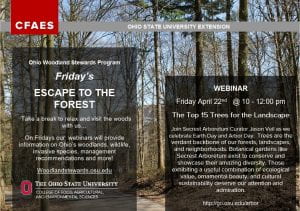MANSFIELD, Ohio—If you’re new or new-ish to making maple syrup, there’s a lot you can learn at Maple Bootcamp: Ohio.
Set for June 22–24 at The Ohio State University at Mansfield, the event, its website says, will provide “intensive hands-on training for beginner and intermediate maple producers.”
Participants will get details on how to assess a sugarbush and all the steps that follow, from collecting sap to boiling, bottling, and selling. Classroom sessions will take place on the Ohio State Mansfield campus. Field trips and tours will visit local maple operations, including one located right on the campus.
By the end of the program, participants “will gain the skills necessary for the safe, efficient, and profitable production of maple products,” says event co-organizer Kathy Smith of Ohio State’s College of Food, Agricultural, and Environmental Sciences (CFAES).
Smith, who is forestry program director for the CFAES School of Environment and Natural Resources (SENR), looks at some of the bootcamp topics:
1. What trees to tap
“While sugar maple is considered ‘the’ tree to tap for syrup, there are also other maples you can tap,” Smith says. These include black maple, red maple, silver maple, and a hybrid found in Ohio, a red maple-silver maple cross.
“Sugar and black maples produce sap with a high sugar content, which means less sap boiling,” Smith says. “But today’s technology can make some of the other species pretty competitive.”
The bootcamp will teach how to identify the different maple species, and will cover the differences between them when it comes to making syrup.
2. How to install a tap
“Proper tapping procedure minimizes the impact on the health of the tree,” Smith says. Most producers today use 20-volt cordless drills to drill their taps, she says, and the size of the bit and the depth of the hole both are critical. The bootcamp will cover them both, with the goal being that “you’re trying to tap without jeopardizing the health of the tree.”
3. How many taps to have
Producers have a rule of thumb for how many taps a tree should have. It’s based on the tree’s diameter when measured 4.5 feet off the ground. A bootcamp session will explain the rule and how and why to use it.
“You never want to overtap your trees, as the point is to not shorten their productive lifespan,” Smith says. “The more holes, broken branches, etc., a tree has, the more difficult it may be for the tree to produce the pressure needed to get the sap flowing.”
4. How and when sap flows
Temperatures dictate sap flow, Smith says. Nights in the 20s and days in the 40s are key. When the thermometer goes above 32 degrees Fahrenheit, pressure in the tree makes the sap flow. But if temps stay below 32, the likelihood of having the right pressure—enough to make the sap flow—is “slim,” Smith says.
Understanding sap flow and the role of temperature, set to be covered at the bootcamp, “will lead to a more successful season,” Smith says. She notes that “maple producers become weather fanatics when January rolls around.”
5. How to collect sap
Buckets, bags, and tubing are options when it comes to collecting sap. Having the sap go into a storage tank, or directly into the evaporator, also are choices to make. The bootcamp will help participants determine which methods are best for their own operation. Regardless, “Make sure that whatever collection container you use is food grade,” Smith says.
6. How to store and filter sap
Are you selling your syrup? Or is it only for home consumption? “That may make the difference in deciding whether to filter or not,” Smith says, adding also that “storage for raw sap is different than storage for processed syrup.” The bootcamp will look at the pros, cons, and differences among the options.
7. How to make value-added products
Maple syrup can be used for making a range of value-added products. A bootcamp session will explore the possibilities—from maple cream to maple candy to granulated maple sugar—and what it takes to produce them.
8. How to market what you make
“Knowing how you want to distribute what you make is key to a successful operation,” Smith says. Just for friends and family? Sold from the farm or at a farmers market or by arrangement in a local store? A bootcamp session will look at the options and what’s needed to carry them out.
Details and registration
The complete list of sessions and other details can be found in the event flier at go.osu.edu/maplebootcamp.
Registration for Maple Bootcamp: Ohio is $150. Participants can register using the form in the flier, or online at woodlandstewards.osu.edu. Registering ahead of time is required. The deadline to register is June 14.
Ohio State Mansfield is located about 80 miles south of Cleveland and 65 miles north of Columbus.
3-state effort
Along with Ohio State, CFAES, and SENR, the event co-hosts also include Penn State Extension and West Virginia’s Future Generations University (FGU).
The event is being funded by a grant to SENR, Penn State, and FGU from the U.S. Department of Agriculture’s Acer Access and Development Program. The grant aims to promote maple syrup production in Ohio, Pennsylvania, and West Virginia through education and research.






